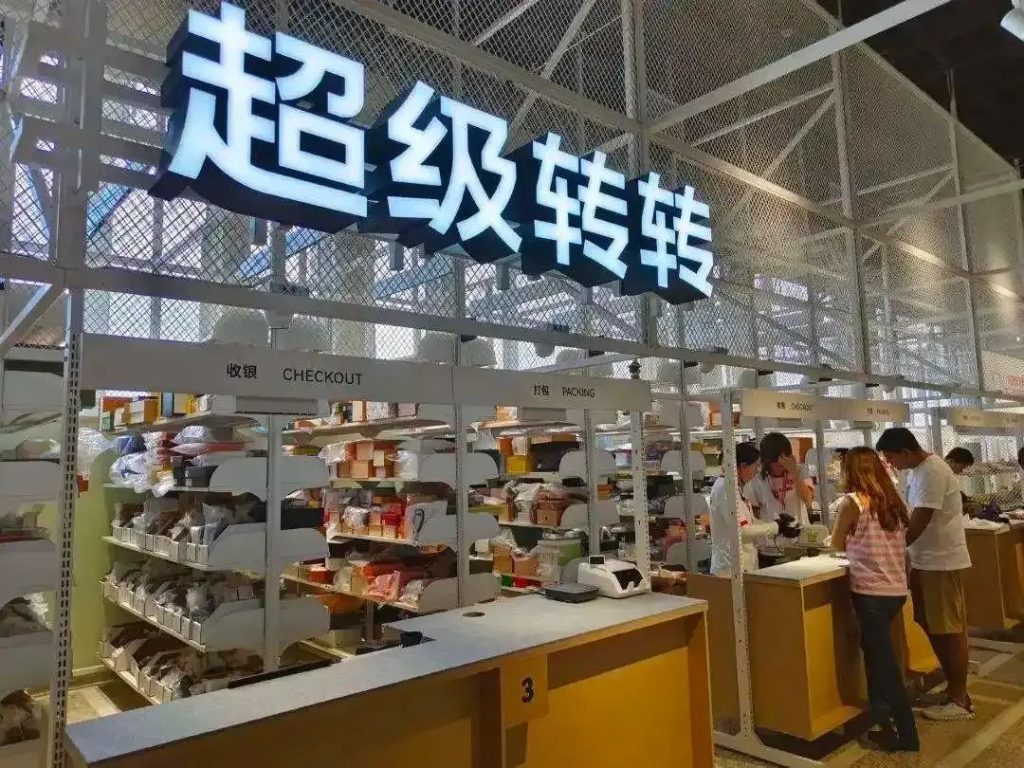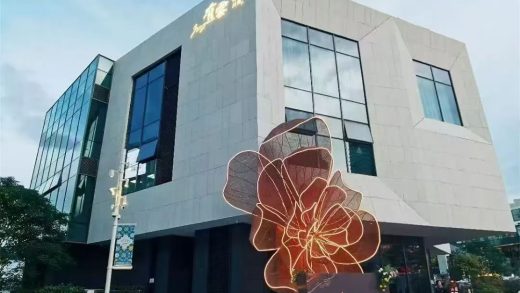
Read More《转转开启3000平大店,二奢真这么赚?》
Warehouse-style Big Stores: Accelerators for the Scaling of the Second-hand Economy and the Popularization of the Circular Concept
In recent years, the domestic second-hand economy has witnessed explosive growth. Platforms such as Zhuanzhuan and Zhi’er are using “warehouse-style big stores” as a key strategy to drive this sector from “niche experimentation” to “mainstream penetration.” From the 3,000-square-meter “Super Zhuanzhuan” store in Beijing’s Guomao area to the 10,000-square-meter “Zhi’er Transparent Warehouse” in Shanghai, the opening of these big stores has not only redefined the consumption scenarios for second-hand luxury goods (second-hand luxury, or “二奢” in Chinese), but also become a crucial driving force for the large-scale development of the second-hand economy and the popularization of the circular concept.
First of all, warehouse-style big stores break down the trust barriers in second-hand transactions through “centralized inventory + innovative scenarios.” In traditional second-hand transactions, users’ doubts about the authenticity, condition, and price of goods are the core pain points. The big stores of Zhuanzhuan and Zhi’er transform the “invisible and intangible” online transactions into “tangible and comparable” offline experiences through standardized displays, transparent information (such as price inquiries by scanning QR codes and the display of appraisal reports), and self-service shopping models. For example, in Super Zhuanzhuan, top luxury bags from brands like Louis Vuitton and Hermès are displayed in different grades according to their condition. Users can wear white gloves to freely select items and scan the QR codes to view the defect points and historical prices. This “warehouse-style” open atmosphere significantly reduces users’ decision-making costs. Data shows that the return rate of Super Zhuanzhuan has dropped to one-tenth of that of online transactions, which is a direct reflection of the increased user trust.
Secondly, the big store model accelerates the price transparency in the second-hand luxury market and promotes the industry’s shift from being “driven by information asymmetry” to being “value-driven.” In the past, small and medium-sized second-hand luxury stores relied on “information asymmetry” to make profits from price differences. The price of the same popular bag could vary by thousands of yuan across different channels. However, the big stores of Zhuanzhuan and Zhi’er have broken this model with “fixed prices + cross-channel price comparison.” For instance, the popular Louis Vuitton Onthego large bag is priced at 8,000 yuan (the official price is 25,000 yuan) in Super Zhuanzhuan, the new YSL Niki 99 is only one-fourth of the official price, and the GUCCI 1955 bag is even as low as 6,000 yuan (the official price is over 20,000 yuan). This price transparency forces the industry to return to the “real value of goods,” allowing consumers to obtain high-quality second-hand goods at more reasonable prices. It also helps the platforms build a reputation for “cost-effectiveness” and attract more new users.
More importantly, the big store model promotes the upgrade of the second-hand circular economy from a “single-category” to a “lifestyle” through “second-hand luxury goods as a draw + multi-category synergy.” Although the big stores of Zhuanzhuan and Zhi’er focus on second-hand luxury goods, they are not limited to this category. Super Zhuanzhuan has set up a digital technology area for cameras, game consoles, jewelry, etc., while Zhi’er has expanded to include men’s and children’s product sections and even launched a low-price area for items under 1,000 yuan. This “one-stop” multi-category layout allows users to be exposed to more second-hand goods (such as second-hand cameras and game consoles) while purchasing second-hand luxury goods, thereby lowering their psychological barriers to second-hand transactions. As Huang Wei, the CEO of Zhuanzhuan, said, “The core of offline big stores is to let users see that’second-hand goods are good things.'” When users expand from “buying a second-hand bag” to “buying a second-hand camera or game console,” second-hand circulation is no longer an occasional behavior but gradually becomes a daily consumption habit. The formation of this habit will feed back to the supply side from the demand side, attracting more users to participate in second-hand transactions (such as selling idle items), and ultimately forming a positive cycle of “abundant supply – active users – more abundant supply.”
Hidden Worries Behind the Prosperity: Dual Challenges of Industry Ecosystem and Operational Risks
Although warehouse-style big stores have injected new impetus into the second-hand economy, their rapid expansion has also exposed potential problems in the industry ecosystem and operations. There is a need to be vigilant against the imbalance between “scale expansion” and “quality development.”
The first issue is the squeeze on the survival space of small and medium-sized second-hand luxury stores. In the past, small and medium-sized second-hand luxury stores carved out a niche in the market with the unique aesthetics of their owners, niche product selections (such as rare vintage styles), and “high-end” store decorations. However, the “popular item concentration + price transparency” model of big stores has directly impacted the core advantages of small and medium-sized stores. On the one hand, big stores can obtain popular items (such as Louis Vuitton and GUCCI products) at a lower cost through large-scale procurement and standardized operations, making it difficult for small and medium-sized stores to compete on price. On the other hand, the “de-mystified” display in big stores (such as lining up Louis Vuitton bags like “supermarket products”) has weakened the “scarcity” and “ritual sense” of luxury goods, making users more inclined to choose big stores with “large quantities and low prices” rather than “small and beautiful” vintage stores. Some users have reported that a GUCCI bamboo bag they bought for 4,500 yuan at a vintage store in Sanlitun only costs 2,000 yuan at Super Zhuanzhuan. This comparison has directly eroded the competitiveness of small and medium-sized stores. Although big stores currently cover rare vintage styles less frequently, as users’ aesthetics improve and big stores expand their product selections, the “differentiation space” for small and medium-sized stores may further shrink.
Secondly, the challenges of authenticating and anti-counterfeiting non-standard products remain a “bottleneck” problem for the industry. Second-hand luxury goods are typical non-standard products, and their authenticity, condition, and value highly depend on professional appraisals. Although Zhuanzhuan and Zhi’er have set up quality inspection teams (such as Zhuanzhuan’s second-hand product inspection system), the existing technology is still insufficient in the face of increasingly sophisticated “refurbishers” and “counterfeiting teams.” For example, there are now mass-produced fake Chanel original packaging (sold for less than 100 yuan), forged warranty cards and anti-counterfeiting labels in the market, and even chemical treatments to make old bags look “brand new,” making it difficult for ordinary consumers to distinguish. Even professional appraisers on the platforms may make misjudgments due to the upgrading of “high-quality counterfeiting techniques.” If the problem of fake goods occurs frequently, it will not only damage users’ trust but also have a negative impact on the reputation of the entire second-hand economy.
In addition, the operational risks of the heavy-asset model cannot be ignored. Zhuanzhuan’s 3,000-square-meter big store is located in Beijing’s Guomao business district, and Zhi’er’s 10,000-square-meter transparent warehouse is in prime locations such as Shanghai’s Hongqiao area. The rent, decoration, and labor costs for such stores are extremely high. Taking the Guomao business district in Beijing as an example, the monthly rent for a 3,000-square-meter commercial space may exceed one million yuan. Coupled with the operational costs of display, warehousing, and quality inspection, big stores need to maintain a very high flow of people and turnover rate to make a profit. Although Super Zhuanzhuan currently has a good performance in terms of footfall and sales, once the market enthusiasm wanes or users’ consumption habits change (such as a return to online shopping), the heavy-asset investment may become a heavy burden. Moreover, the “single inventory, dual sales channels” model (simultaneous online and offline sales) of big stores, while improving the circulation efficiency, also places higher requirements on inventory management. If a certain type of product becomes unsalable, it may lead to pressure on the capital chain.
Suggestions for Entrepreneurs
In the face of the “big store boom” in the second-hand economy, entrepreneurs need to find a balance between opportunities and risks based on their own resources and positioning. Here are some specific suggestions:
-
Small and medium-sized second-hand luxury store owners: Focus on “differentiation” and shift from “information asymmetry” to “aesthetic sense”
Although the big store model has squeezed the market for popular items, there are still opportunities for rare vintage styles and second-hand bags from designer brands. Small and medium-sized store owners can enhance their “product selection aesthetics” by exploring niche brands (such as Moynat and Delvaux) or classic styles with a sense of history and convey cultural values by telling the “stories” of the bags. At the same time, they can optimize the offline experience (such as providing professional cleaning and maintenance services) to create a “warm” community-style store that complements the “standardization” of big stores. -
Platform entrepreneurs: Strengthen the dual barriers of “authentication technology” and “supply chain”
The core of the second-hand economy is trust, and the foundation of trust is “authenticity” and “value.” Platforms need to increase investment in authentication technology (such as introducing AI image recognition and blockchain traceability) and establish a standardized system covering the entire process from “receiving goods – authentication – pricing – after-sales service.” At the same time, they should optimize supply chain management and expand the high-quality inventory through models such as C2B (user consignment) and B2B (cooperation with brands/dealers) to reduce inventory risks. -
New entrants: Explore the “small and beautiful” or “community-based” model
If resources are limited, entrepreneurs can refer to Xianyu’s “offline circular store” model, focusing on a 2 – 3 kilometer radius within the community and providing full-category consignment services (from small items worth a few dozen yuan to second-hand luxury goods worth thousands of yuan). They can attract users with “high-frequency, low-price” products and then gradually penetrate into high-unit-price categories such as second-hand luxury goods. This model requires low investment, is easy to replicate, and is more suitable for regional expansion. -
All entrepreneurs: Continuously convey the “circular value” rather than just selling products
The ultimate goal of the second-hand economy is to promote a “circular lifestyle” rather than simply selling second-hand goods. Entrepreneurs need to strengthen users’ awareness of “environmental protection,” “cost-effectiveness,” and “sustainability” through content marketing (such as live-streaming to popularize the history of second-hand luxury goods and holding old-item transformation activities) and user interaction (such as encouraging users to share their idle item stories), and upgrade “buying second-hand” from a “money-saving behavior” to a “value recognition.”
The “big store era” of the second-hand economy has arrived. It is not only a milestone in the industry’s scaling but also a long-term test of “trust, efficiency, and ecosystem.” For entrepreneurs, grasping the core of “user experience” and “value delivery” and maintaining a sense of awe towards risks during expansion are the keys to achieving long-term success in the blue ocean of the second-hand economy.
Latest
- Startup Commentary”The Incomplete Evolution History of Bathing Centers”
- Startup Commentary”Starting from 358,800 yuan, Maserati Slashes Prices Drastically to Survive”
- Startup Commentary”Monopoly: Always the Best Business”
- Startup Commentary”A PE Giant Spent $6.6 Billion on a Crematorium”
- Startup Commentary”In a Low-Sports Year, Social Assets Still Hold Great Value”





